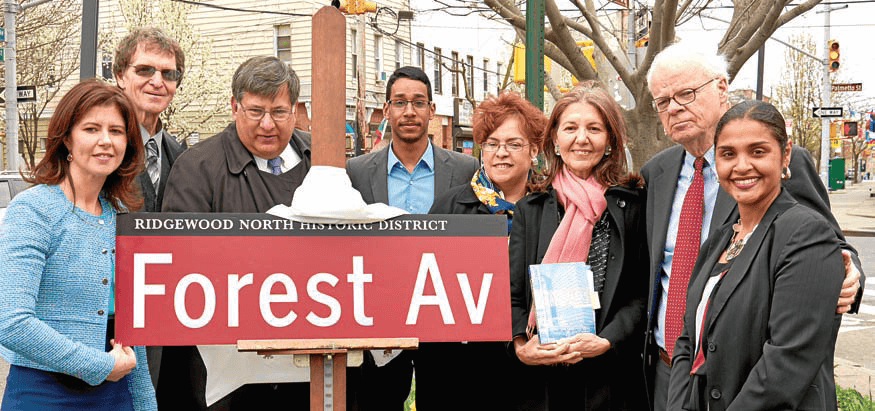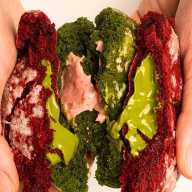From the beginning, they were something special. The apartment houses rose in the heart of Ridgewood, Queens in stark contrast to the dark and dingy tenements thousands of Lower Manhattan residents called home. Not only were they spacious, bright and airy, but they also offered those lucky enough to own one a way to climb the economic ladder and achieve real economic success.
Like many American success stories, the tale of the Mathews Flats has its roots in Europe. The Mathews brothers who built them were from Paltino in Bavaria, Germany, in the early 1900.
Gustave Xavius Mathews, who was born in 1871, came to America with his brothers in 1886. In 1900, he married Clara Kuntz, whose father was a builder. They had four children: Ernest L., Curtis, William Elliott and Gustave X. Jr.
Gustave Mathews began building homes in 1903; on July 2, 1904, Mathews Realty and Construction Company purchased from Peter Wyckoff a strip of land 100 feet wide and 600 feet long — located on what is today the north side of Linden Street from Seneca Avenue to about 100 feet east of St. Nicholas Avenue.

Wyckoff took a purchase money mortgage for the property, and Mathews Realty agreed to build on the property within a decade. Although the deed specifies the sale was made for “$1 and other valuable considerations,” from the down payment on the mortgages, it is believed the land sold for $22,826 per acre.
When the Wyckoff Farm was divided, the dividing line ran approximately north to south 100 feet east of what is today St. Nicholas Avenue. Peter Wyckoff owned the land east of the line, and his brother Nicholas owned the land to the west.
Mathews Realty and Construction was owned 50 percent by William Matthews, Gustave’s older brother, who served as president. The other share was split between Gustave and younger brother Ernest, who was secretary.
In October 1904, Matthews Realty and Construction obtained a $45,000 mortgage for a 243 foot frontage on Linden Street, west of Cypress Avenue, laying out 10 lots of 19.9 by 100 feet, and two lots of 22 feet by 100 feet. The German Savings Bank, which provided the mortgage, set the interest at five percent, and require repayment by Dec. 1, 1905.
The Mathews company also built houses on Grove Street and Bleecker Street.

Building the flats
About 1907, the Tenement House Law changed and, as a result, Gustave Mathews and his brothers designed a six-family, three-story brick house on a 27 1/2’-wide plot, 100’-feet deep, with a backyard. They used light-colored brick with red trim and included large airshafts so every room had a window with fresh air.
Each of the flats had five rooms plus a bath.
That year, the Mathews Brothers purchased the Thomas Fleckenstein Farm on Forest Avenue and began building six-family houses. Each were sold for $11,000, with buyers required to pay a $2,000 cash down payment, and the remainder in easy payments.
Inasmuch as the landlord was able to rent the flats for $15 to $16 per month, the rental income was $1,140 per year, sufficient to pay the mortgage payments plus taxes, water and upkeep charges. The reception to the houses was excellent.
In building the houses, they laid sewers, paved the streets and installed curbs.
Most of the bricks for the houses came from Kreischer Brick Company in Staten Island. The Ridgewood Iron Works provided the iron work for the gates, fences and stoop railings. Woodwork came from Charles Rothbach Inc.
Builders were paid about $18 per week by the various contractors, with all workers putting in a 48-hour, six-day work week.
As a result of the sales of the Mathews Flats at the Fleckenstein Farm, the following year, the company negotiated with the heirs of Joachim Meirose (the family would later change the name to Meyerrose) to purchase the family farm.
Joachim Meirose originally purchased 8.67 acres from John C. Debevoise on Mar. 18, 1853 for $6,936, or $800 per acre, for land bounded on the north by the neighboring farm of John C. Doscher, on the east by Woodward avenue and on the west by lands belonging to Ann Onderdonk.
The heirs of Joachim Meirose—Richard and Joseph Meyerrose, and Margaret Meyerrose Brunies—were reportedly paid $20,000 by the Mathews Brothers for most of the farm.
On Mar. 6, 1909, the Meyerroses sold another 1.28 acres on the north side of Catalpa Avenue to the Diocese of Brooklyn, led by Bishop Charles McDonnell. St. Matthias Church and School would be developed there.
Meantime, the Mathews Brothers began building on Magnolia Street (now Gates Avenue) and Palmetto Street.
On Sept. 28, 1911, the Meyerrose heirs sold the farmhouse and barns remaining on what would later become the southwest corner of Cornelia Street (now 68th Avenue) and Woodward Avenue. The Mathews brothers demolished the structures to make way for more of their homes.

Model homes
That very same day, the stockholders of the G.X. Mathews Company— based with an office at 2040 Palmetto St.— mortgaged a 462 x 100 foot section of land for $114,500 with the Dime Savings Bank in Williamsburg. This land was located on the north side of Cornelia Street between Woodward and Onderdonk avenues.
The parcel was divided into 15 interior lots carrying a mortgage of $6,500 each and two corner lots with mortgages of $8,500 each. Shortly thereafter, up came more Mathews flats.
In all, the Mathews Brothers built 650 of their six-family homes along Madison Street, Putnam Avenue, Cornelia Street, Woodbine Street, Gates Avenue and Palmetto Street. They also built smaller homes along Linden Street, Grove Street and Bleecker Street.
So revolutionary were the Mathews Flats that they were exhibited in 1915 at the Panama-Pacific Fair in San Francisco; the New York City Tenement Housing Department hailed them as an outstanding example of housing.
The thrift of the people who placed their money in he savings banks generated the capital to make the buildings of these homes possible. Also, the industrious nature of the Mathews Brothers, particularly Gustave Mathews, and their meticulous attention to detail insured good workmanship to make these houses a worthwhile, long-term investment.
Indeed, to this day, the Mathews Flats remain a worthwhile investment. The good news is that many of those buildings now in Ridgewood’s three historic districts (North, South and Central) fall under landmark protection. Any changes to the exterior of the homes in these districts must meet Landmarks Preservation Commission approval and be “in character” with the building’s nature.

While some owners might find it inconvenient, the process ensure the Mathews flats will be here to stay so that future generations may relish the opportunity to live in some of our community’s finest apartments.
Reprinted from the Nov. 6, 2014 Ridgewood Times.
* * *
If you have any memories and photos that you’d like to share about “Our Neighborhood:The Way it Was,” write to The Old Timer, c/o Ridgewood Times, 38-15 Bell Blvd., Bayside, NY 11361, or send an email to editorial@ridgewoodtimes.com. All mailed pictures will be carefully returned upon request.




































